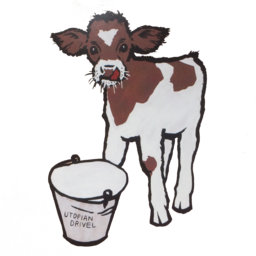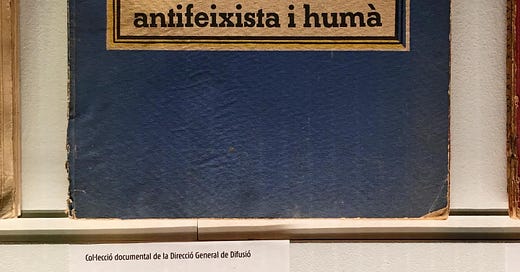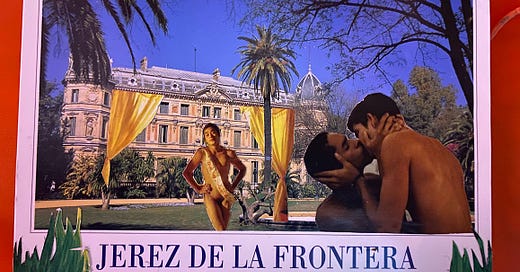‘I tell ya, if it’s sex you’re after, get a load of the stuff I’m wearing.’ In a 1994 episode of the BBC teen drama Byker Grove, Gary Hendrix is talking about getting girls. He invites his fresh-faced friend Noddy Fishwick to smell his aftershave as they sit in a cinema, waiting for the film to begin. ‘Well, go on then,’ Noddy says. He leans in, pauses for a second, then kisses Gary on the cheek. A slow-dawning horror spreads across Gary’s face; the kiss, the intimacy, the arm around his shoulder – it’s not what he had in mind at all. There’s a moment where it seems he might just brush it under the carpet, but soon a panic sets in. He quickly gets to his feet and heads for the aisle. ‘You just stay away from us yer hear?’ he warns Noddy. ‘Yer sick man, sick. Sick! Sick I tell yer!’ His words reverberated around the cinema and, for young gay viewers, around the head: in the general atmosphere of homophobia in the UK in the early 1990s, such a response seemed almost inevitable.
Heartstopper, originally a graphic novel written and illustrated by Alice Oseman and now a popular Netflix series, couldn’t be further from the Northern working-class realism of Byker Grove. Set among a group of middle-class grammar school pupils in the Home Counties, the book and show have won plaudits for representing young gay love without the drama – no tortured self-doubt, no violent rejection of advances, no social ostracism. Charlie Spring (played in the Netflix adaptation by Joe Locke) is a boy in Year 10 who was accidentally outed the year before. His life revolves mainly around his friendship group of other artsy teenagers – misfits, but not outcasts – including Tao, a cinephile; Tara and Darcy, a bright and easy-going lesbian couple; and Elle, an emotionally intelligent painter who has recently moved to the local girls’ grammar school following her transition.
By chance, Charlie is assigned a seat next to Nick Nelson (Kit Connor), an athletic boy in Year 11 who encapsulates everything Charlie is not. While Charlie eats his lunch in the art block to avoid bullies, Nick is the boisterous, charming star of the rugby team. Charlie is slim and dark-haired, Nick is muscular and fair. And yet, wouldn’t you know it, between this unlikely pair the spark of romance ignites. What little drama there is comes early on. Charlie already has a sort-of boyfriend, Ben (Sebastian Croft), who is dating a girl yet keeps trying to kiss him in quiet library corners, by force if necessary. In public, however, Ben distances himself from Charlie. Charlie begins to fall for Nick when, catching Ben attempting to kiss him without his consent, Nick intervenes. As they become closer, Nick realises that his feelings for Charlie are more than friendly, and eventually they kiss at a 16th birthday party.
Charlie as represented by Joe Locke in the Netflix adaptation, and in the original novel
After some brief googling, Nick comes out as bisexual. He and Charlie get together; their friends are cool, their parents are supportive, and some of their teachers are also gay. Drama safely navigated by the end of Volume Two (2019), the subsequent books trace the quotidian delights of their relationship: reassuring each other, hugging a lot and kissing occasionally, negotiating trauma, discussing their mental health, listening to each other’s needs, validating each other’s self-worth and never, ever masturbating. You know, the stuff teenage boys do.
In fact, actual sex, sloppy and scary, is almost totally absent. When it does appear, it exists exclusively as a function of romance, a thing you finally do to ‘take your love to the next level.’ This omission might be the key to understanding the make-up of Heartstopper’s audience, for whom the absence of realistic teenage male sexuality is precisely what makes it so attractive. It originated as a webtoon, a serialised online comic designed to be read on a phone, and still premieres for free on Oseman’s Tumblr and webtoon pages. The many tens of thousands of comments on the webtoon give some insight into just what attracts fans to the story. ‘As a sex repulsed asexual person I love how this is shown, it’s not sexualising them for the audience, this is just for them,’ a commenter writes under a scene where, in Volume Five (2023), Charlie and Nick finally have sex, depicted through clasped hands, stars and a cut scene to photos of the boys on the bedroom wall. ‘This scene is so beautiful to me,’ reads another comment. ‘They aren’t fetishised and nothing is shown, just a simple hand squeeze to reflect such an intimate moment of love between two young boys.’
Yet even this discreet sex scene, built after years of romance and rehearsed affirmations of consent, is too much for some. One reader thinks that ‘something has just felt off for awhile now since they’ve started going further with their relationship. everyone’s like “AYY IT HAPPENED” but it feels off to me.’ Another comment hints at a sense of betrayal: “no cuz this is one of the very few comics that i dont spend the entire time waitinb for the smut. i dont feel like i need to see them have sex lol. i dont even know if i wang to see them have sex. they r my adorable wholesome little guys and i love them.” For a book about two homosexuals, a vague sense of disgust for actual homosex – smut! heaven forfend! – lingers both among its fans and in the text itself. ‘I just wanna say I appreciate the author so much for not fetishising gay men,’ another reader writes. What does fetishing mean in this context? Acknowledging that homosexuality is built primarily on man-on-man sexual desire? Sorry, but it is: the clue is in the name.
Kit Connor and Joe Locke as Nick and Charlie
Clearly for some fans the ‘sex’ part of ‘homosexual’ is the problem, and this echoes within the books themselves. It doesn’t feel like a coincidence that Ben, the only male character who is attracted to men because he finds them sexually desirable rather than lovable, is also depicted as a manipulative predator who sexually assaults Charlie. Nor is it insignificant that the assault is interrupted by Nick, who at this point is still outwardly straight. Sex gets a bad rap in Heartstopper, but romance – and a particularly gendered form of romance, based on old-fashioned models of power and care – is everywhere. Charlie and Nick betray a crude homosexual dimorphism, to coin a phrase, that doesn’t take a huge leap of imagination to recognise as gendered when read within the frame of more reactionary romance novels. Charlie is frail and weak, a classic English rose, his relationship with his body complicated by an eating disorder and an unwillingness to be seen naked. He suffers from poor mental health and sometimes self-harms. Nick arrives as a white knight, a man to save him from himself; Charlie stands on his tiptoes to kiss him, and steals his sweatshirts, and relies on him as a protector. Nick speaks for Charlie in public and looks after him when he’s drunk too much. It’s only once Charlie is under Nick’s protective shield that his creativity and sensitivity are allowed to flourish. It’s only once Nick encounters Charlie’s gentle, admiring openness that he is able to drop his machismo and embrace his affectionate side. Ideologically speaking, it’s borderline tradwife.
In this respect Charlie bears a more than passing resemblance to the protagonist of another recent bestseller about young gay men that wasn’t written by a gay man, Hanya Yanagihara’s A Little Life (2015). Like Charlie, Jude St Francis is a gay man rescued from abuse at the hands of predatory gay men by the unpushy affections of a newly minted bisexual, Willem, a bisexual unsullied and untroubled by any prior experience of homosexual touch. Like Charlie, all of Jude’s trauma is written into the past of the narrative, a lingering trace of homo-hypersexuality that haunts as self-harm and mental illness and threatens to undermine the idyll of comfort and wealth provided by the masculine bisexual man in the present. (Not only does Heartstopper distance trauma through flashbacks, but even the internal dilemmas and motivations of the here-and-now have their own handy literary device, being shown through the typing then deleting of instagram messages, rather than living implicit in the character’s behaviours and responses.) In her review of A Little Life for Vulture, critic Andrea Long Chu suggests that Yanagihara gives an impression of being “somewhere high above with a magnifying glass, burning her beautiful boys like ants.” The author betrays a touristic interest in gay men, while also treating them as “perfect patients,” recipients of both her virtuosic cruelty and her “maternal posture of excessive protectiveness.” Oseman and her readers seem to nurse Charlie too, and hopefully not let him fuck.
Antoni Porowski, the eating man’s himbo, in his A Little Life/Experimental Jetset mashup t-shirt
Proust, in what Edmund White has identified as the ‘Albertine strategy’, placed a fictional female character in a relationship with his narrator as a way of depicting his own real-life relationship with a man (his chauffeur, Alfred Agostinelli). For much of her audience Oseman appears to be doing the reverse, using a loving, consensual gay romance as a stand-in for a dreamed-of heterosexual relationship in which a young female reader might not be objectified, coerced and degraded, but cared for and regarded as an equal. Of course, Oseman could have tried to represent that in a teenage male-female relationship, but some things are just too far out of the realms of believability. For Heartstopper’s readers, gay men are useful avatars for an approachable, unthreatening maleness right up to the point where they display sexual desire detached from love, at which point they become men again, but worse. In its relentless urge to save the ideal of homosexuality from the dreaded hypersexuality of actually-existing homosexuals, Heartstopper might just as easily be titled A Little Life For Teens.
In theory, young adult fiction is written for readers aged between twelve and eighteen, but studies have found that three quarters are in fact adults, and more than a quarter are over the age of 28. The audience for Heartstopper on Netflix seems to be broadly similar: one study found that 71 per cent of its viewers are female, and a quarter are women aged 18-29. These women have been raised in a world that is often hostile to their desires and aggressive in pursuit of their bodies. They have come of age in the era of sexting, deepfakes, revenge porn and the ascendancy of Andrew Tate and the “manosphere”. One can hardly blame them if, in navigating their own wishes for love and affection, they find comfort in an idealised story in which, for once, they are mercifully not represented. Yet the idealism that makes Heartstopper so attractive to its fans is also what lets it down. It’s heavy on what proper moral behaviour should be, how a Good Queer should behave, and rather light on what to do when messy reality intrudes. How is a young gay man supposed to react when his first bisexual, rugby-playing boyfriend isn’t accommodating of his emotions, or when he finds that other teenagers don’t have deep reservoirs of compassion? Its idealism leaves one with the lingering sense that you’re reading a conduct book, that genre of 18th and 19th century literature that provided young men and women with moral education as to the proper way to behave in society, or perhaps a “mirror for princes,” books that offered young mediaeval aristocrats guidance for proper courtly and kingly conduct. It’s not a reflection of how life is, but how it ought to be, so take note.
Sebastian Croft as Ben Hope
Heartstopper has a very different pedagogical function to Byker Grove, which recognised that teen drama could fulfill the Reithian imperative to educate as well as entertain on issues where schools and parents might fear to tread. Noddy’s kiss, the first gay kiss shown on children’s TV in the UK, was no exception: in addressing both his own sense of confusion and the homophobia he would experience when he confided in his friends, the storyline provided young gay viewers in the Section 28 era with a framework for understanding not only their own sexuality, but the emotions and responses of their peers. It showed teenagers learning, changing their behaviour and maturing into adults.
Of course, depictions of queer life need not be miserable, but the idealism on which Heartstopper is built feels curiously narcissistic. Conflict, unethical behaviour, cruelty and unkindness are things we all do and are all subject to. But Heartstopper belongs to a different political-cultural moment, where a crude concept of ‘representation’ is a moral and aesthetic good in its own right (never mind that literature is one field where white gay men have hardly been underrepresented). When it comes to queerness, “representation” often means “an image of myself I’m comfortable seeing”, and anything else is a compounded oppression. It was described in the Gay Times as “the queer graphic novel we wished we had at high school” and has won its plaudits precisely for its idealistic representation of gay teens. But it’s an idealism that has confused representation for endorsement to the point where even heavily signposting inappropriate behaviour is not enough; good queer characters must remain unblemished innocents who don’t do bad things, and bad characters must remain alien. Despite these signposts towards his innate evil, to my mind Ben remains the most engaging character, despite his abusive treatment of Charlie, because he is the one who feels most intensely the abjection thrust upon teenage boys who desire other teenage boys. He’s driven to cruelty as a way to distance himself from the tarnishing brush of homosexuality. He wants, he desires, but existing in a world that stigmatises those desires makes him cold, anxious and secretive. That’s a real reflection of a complex inner conflict. There’s little empathy in Heartstopper for such a character, only more judgement.
If Heartstopper’s teenage audience require any moral lessons from their literature, it’s surely not that they must emulate these models of queer moral perfection in order to be loved and cared about. It’s hard enough navigating new emotions and desires as a teenager without the fear of perdition for getting something wrong. For its adult readers, it seems to flatter us with a sense that victimhood is a moral good in its own right, regardless of what you do with it. It’s a curiously teenage attitude for adults to take: in reality, while our mistakes and insecurities don’t condemn us forever, neither do our experiences of oppression sanctify us.
If you enjoying reading this, why not share it with a friend?
If you’d like to read more of my work, please do subscribe to this newsletter. It’s been going for five years, so there are hundreds of essays to read. Paid subscribers get access to the whole archive, and subscribing to independent substacks helps writers like me not just produce essays like this one, but realise larger projects like new books (*cough cough*). Why not start with this one, about The Funeral of Her Majesty Queen Elizabeth II as seen from the vantage of a Gay Sauna in London?














